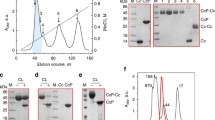Abstract
The effect of dicyclohexylcarbodiimide (DCCD) on electron transfer in the acceptor quinone complex of reaction centers (RC) from Rhodobacter sphaeroides is reported. DCCD covalently labelled the RC over a wide concentration range. At low concentrations (<10 μM) the binding was specific for the L subunit. At relatively high concentrations (>100 μM) DCCD accelerated the rate of charge recombination of the P+QB - state, consistent with a decrease in the equilibrium constant between QA -QB and QAQB -. At similar concentrations, in the presence of cytochrome c as exogenous donor, turnover of the RC was inhibited such that only three cytochromes were oxidized in a train of flashes. Both these inhibitory effects were fully reversed by dialysis, indicating that stable covalent binding was not involved. Possible mechanisms of action are discussed in terms of the putative role of specific residues in proton transfer and protonation and release of quinol from the RC.
Similar content being viewed by others
References
Albertson NF (1961) Synthesis of peptides with mixed anhydrides. Organic Reactions 12: 157–226
Allen JP, Feher G, Yeates TO, Komiya H and Rees DC (1988) Structure of the reaction center from Rhodobacter sphaeroides R26: Protein-cofactor (quinones and Fe2+) interactions. Proc Natl Acad Sci USA 85: 8487–8491
Beechey RB, Roberton AM, Holloway CT and Knight IG (1967) The properties of dicyclohexylcarbodiimide as an inhibitor of oxidative phosphorylation. Biochemistry 6: 3867–3879
Casey RP, Thelen M and Azzi A (1980) Dicyclohexylcarbodiimide binds specifically and covalently to cytochrome c oxidase while inhibiting its H+-translocating activity. J Biol Chem 255: 3994–4000
Crofts AR and Wraight CA (1983) The electrochemical domain of photosynthesis. Biochim Biophys Acta 726: 149–185
Deisenhofer J and Michel H (1989) The photosynthetic reaction centre from the purple bacterium Rhodopseudomonas viridis. EMBO J 8: 2149–2169
Diner BA, Schenck CC and De Vitry C (1984) Effect of inhibitors, redox state and isoprenoid chain length on the affinity of ubiquinone for the secondary acceptor binding site in the reaction centers of photosynthetic bacteria. Biochim Biophys Acta 766: 9–20
Kleinfeld D, Okamura MY and Feher G (1984) Electron transfer in reaction centers of Rhodobacter sphaeroides R26. I. Determination of the charge recombination pathway of D+QAQB - and free energy and kinetic relations between QA -QB and QAQB -. Biochim Biophys Acta 766: 126–140
Kurzer F and Douraghi-Zadeh K (1967) Advances in the chemistry of carbodiimides. Chem Rev 67: 107–152
Maróti P and Wraight CA (1988a) Flash-induced H+-binding by bacterial photosynthetic reaction centers: comparison of spectrophotometric and conductimetric methods. Biochim Biophys Acta 934: 314–328
Maróti P and Wraight CA (1988b) Flash-induced H+-binding by bacterial photosynthetic reaction centers: influences of the redox states of the acceptor quinones and primary donor. Biochim Biophys Acta 934: 329–347
McPherson P, Okamura MY and Feher G (1988) Light-induce proton uptake by photosynthetic reaction centers from Rhodobacter sphaeroides R26.I. Protonation of the one-electron states D+QA -, DQA -, D+QAQB -, DQAQB -. Biochim Biophys Acta 934: 348–368
Michel H, Epp O and Deisenhofer J (1986) Pigment-protein interactions in the photosynthetic reaction centre from Rhodopseudomonas viridis. EMBO J 5: 2445–2451
Mitchell P (1979) Keilin's respiratory chain concept and its chemiosmotic consequences. Science 206: 1148–1159
Paddock M, Rongey SH, Feher G and Okamura MY (1989) Pathway of proton transfer in bacterial reaction centers: Replacement of glutamic acid 212 in the L subunit by glutamine inhibits quinone (secondary acceptor) turnover. Proc Natl Acad Sci USA 86: 6602–6606
Paterson DR (1986) Chemical modification of herbicide binding in thylakoid membranes and bacterial reaction centers. Ph.D. Thesis, University of Illinois. Urbana USA
Pennington RH and Fisher RR (1981) Dicyclohexylcarbodiimide modification of bovine heart mitochondrial transhydrogenase. J Biol Chem 256: 8963–8969
Pototsky NY, Remennikov VG, Kotova EA and Samuilov VD (1981) The inhibition of photosynthetic electron transfer in Rhodospirillum rubrum by N,N′-dicyclohexylcarbodiimide. Biochim Biophys Acta 634: 266–270
Price BD and Brand MD (1982) Proton translocation by the mitochondrial cytochrome bc 1 complex is inhibited by N,N′-dicyclohexylcarbodiimide. Biochem J 206: 419–421
Prochaska LJ and Gross EL (1975) The effect of 1-ethyl-3(3-dimethylaminopropyl)-carbodiimide on calcium binding and associated changes in chloroplast structure and chlorophyll a fluorescence in spinach chloroplasts. Biochim Biophys Acta 376: 126–135
Prochaska LJ, Bisson R, Capaldi RA, Steffens GCM and Buse G (1981) Inhibition of cytochrome c oxidase function by dicyclohexylcarbodiimide. Biochim Biophys Acta 637: 360–373
Stein RR, Castellvi AL, Bogacz JP and Wraight CA (1984) Herbicide-quinone competition in the acceptor complex of photosynthetic reaction centers from Rhodopseudomonas sphaeroides: A bacterial model for PS II herbicide activity in plants. J Cell Biochem 24: 243–259
Takamiya K (1983) Inhibitory effect of N,N′-dicyclohexylcarbodiimide on reduction of cytochrome b 560 and stoichiometry of the reduction in Chromatium chromatophores. J Biochem 94: 1587–1593
Wraight CA (1979) Electron acceptors of bacterial photosynthetic reaction centers. II. H+-binding coupled to secondary electron transfer in the quinone acceptor complex. Biochim Biophys Acta 548: 309–327
Wraight CA and Stein RR (1980) Redox equilibrium in the acceptor quinone complex of isolated reaction centers and the mode of action of o-phenanthroline. FEBS Lett 113: 73–77
Wraight CA and Stein RR (1983) Bacterial reaction centers as a model for Photosystem II: Turnover of the secondary acceptor quinone. In: Inoue Y et al. (eds) The Oxygen Evolving System of Photosynthesis, pp 383–392. New York: Academic Press
Zurrer H, Snozzi M and Bachofen R (1983) Specific binding of DCCD to reaction centers of the photosynthetic bacterium Rhodospirillum rubrum and its effect on certain photosynthetic reactions. FEBS Lett 153: 151–155
Author information
Authors and Affiliations
Rights and permissions
About this article
Cite this article
Paterson, D.R., Wraight, C.A. Inhibition and labelling of isolated reaction centers from Rhodobacter sphaeroides by dicyclohexylcarbodiimide. Photosynth Res 26, 195–201 (1990). https://doi.org/10.1007/BF00033132
Received:
Accepted:
Issue Date:
DOI: https://doi.org/10.1007/BF00033132




